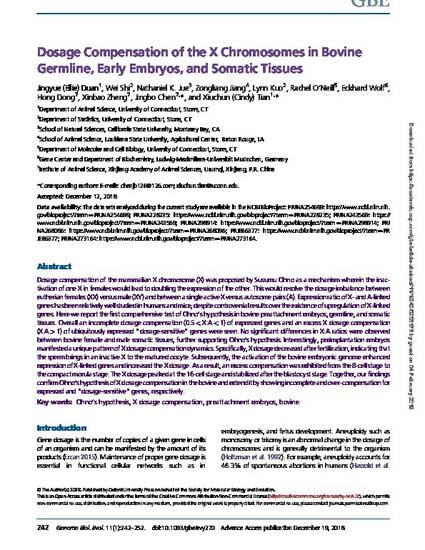
Dosage compensation of the mammalian X chromosome (X) was proposed by Susumu Ohno as a mechanism wherein the inactivation of one X in females would lead to doubling the expression of the other. This would resolve the dosage imbalance between eutherian females (XX) versus male (XY) and between a single active X versus autosome pairs (A). Expression ratio of X- and A-linked genes has been relatively well studied in humans and mice, despite controversial results over the existence of upregulation of X-linked genes. Here we report the first comprehensive test of Ohno’s hypothesis in bovine preattachment embryos, germline, and somatic tissues. Overall an incomplete dosage compensation (0.5 < X:A < 1) of expressed genes and an excess X dosage compensation (X:A > 1) of ubiquitously expressed “dosage-sensitive” genes were seen. No significant differences in X:A ratios were observed between bovine female and male somatic tissues, further supporting Ohno’s hypothesis. Interestingly, preimplantation embryos manifested a unique pattern of X dosage compensation dynamics. Specifically, X dosage decreased after fertilization, indicating that the sperm brings in an inactive X to the matured oocyte. Subsequently, the activation of the bovine embryonic genome enhanced expression of X-linked genes and increased the X dosage. As a result, an excess compensation was exhibited from the 8-cell stage to the compact morula stage. The X dosage peaked at the 16-cell stage and stabilized after the blastocyst stage. Together, our findings confirm Ohno’s hypothesis of X dosage compensation in the bovine and extend it by showing incomplete and over-compensation for expressed and “dosage-sensitive” genes, respectively.
Available at: http://works.bepress.com/jue-nathaniel/16/

Published in Genome Biology and Evolution by Oxford Press. Available via doi: https://doi.org/10.1093/gbe/evy270
© 2018 by the authors. Licensee MDPI, Basel, Switzerland. This article is an open access article distributed under the terms and conditions of the Creative Commons Attribution (CC BY) license (http://creativecommons.org/licenses/by/4.0/).